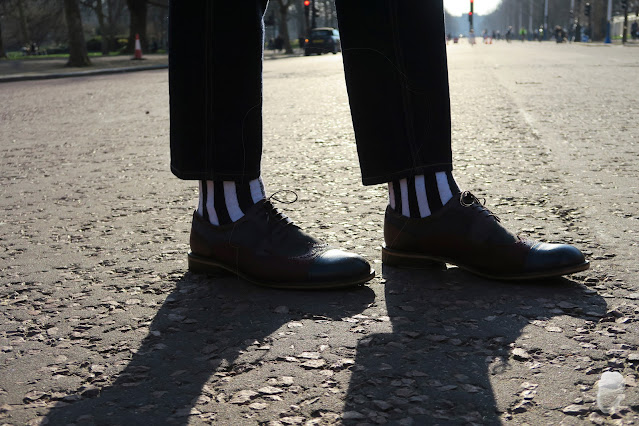No other piece of outerwear embodies distinguishing inherited British style more than the trench coat. Away from the parades and glamour of Hollywood, the trench coat's first leading role was in World War I and its first wearers were soldiers. From Humphrey Bogart to Audrey Hepburn and Kate Moss, the trench coat is now synonymous with oomph and sophistication. The long, heavy wool coats - which had accompanied British forces since the Crimean War in the 1850s - proved inadequate. Instead, the lighter, shorter and waterproof ones, produced by British companies such as Burberry and Aquascutum, worked perfectly. Not only did they offer practical benefits, but the epaulettes displayed official rank, while the buttoned chest-length flap provided additional protection during combat. Map cases could be attached to clothing by rings hanging from the belt. At the top of the back, an extra fabric shield allowed the water to run off without completely wetting the coat. Its subdued colour also played an important role in keeping the soldiers from drawing attention to themselves. Khaki means 'dust' in Hindi. Before that, the uniforms were brightly coloured.
Two names figure prominently in the history of the trench coat. In 1879, Thomas Burberry of Hampshire developed the tight-fitting, water-repellent weave that he later used to make the gabardine coat. To make the coats waterproof, the fabrics were previously waxed or coated with rubber, which made them heavy, stiff, or uncomfortable to wear. In contrast, the gabardine was light, resistant, breathable. Burberry manufactured and distributed about half a million of them during World War I. The London firm Aquascutum, for its part, manufactured garments during the 1850s, which later served as the foundation for the trench coat. Variations on the trench coat worn in World War I have been advertised by a number of companies, including Thresher and Glenny, Gerrish Ames and Simpkins, and Kenneth Durward.
The trench coat is the story of how clothing became part of War technology. The bright hues of armies often referenced the colours of their flags but were also associated with honour. In World War I, French soldiers wore red pants because they felt camouflage was dishonourable. But the British were enthusiastic about khaki from the time of the Indian Mutiny in 1857. It went hand in hand with the belief that pragmatism was more important than honour. When the soldiers returned from battle, there was an idea of heroism and patriotism that people wanted to buy. But after being firmly entrenched in military campaigns, the trench coat took another direction that shaped perceptions of the coat for decades to come.
In parallel, Hollywood made its contribution to the consolidation of the trench coat as a fashion icon. Men were drawn to the effortless look espoused by crime novel detectives, while actresses like Marlene Dietrich became role models for women. Warner Bros. produced a lot of gangster movies, whose characters wore trench coats. By the time of World War II, they were already linked to film noir and Humphrey Bogart. A lot of people remember him wearing the rather characteristic piece in 'Casablanca,' even though he only wore the coat in two scenes. Coats remained a favourite of Hollywood wardrobe departments into the 1960s. Beige in the romantic comedy "Breakfast at Tiffany's” helped confirm Audrey Hepburn's status as a style icon. Today, if you take into account the presence of the trench coat on the catwalks, there are no signs that indicate a decline in its popularity. In terms of fashion, the trench coat has come to win the style war. 100 years after the outbreak of World War I, its beginnings on the battlefields should not be forgotten.
I am wearing a beige oversized trench coat. Classic, long garment with check print in blue, white and red on the lining, collar, lapel, belt and sleeve loop. I am wearing dark jeans and an ivory, puffy, knitted jumper with and oversized, blue shirt underneath. The smart multicoloured shoes match the colour of the trench’s pattern and the stripy socks in white/navy perfectly. A smart but relaxed look that I am completing with the leather tote bag in ivory and navy.































Comments
Post a Comment